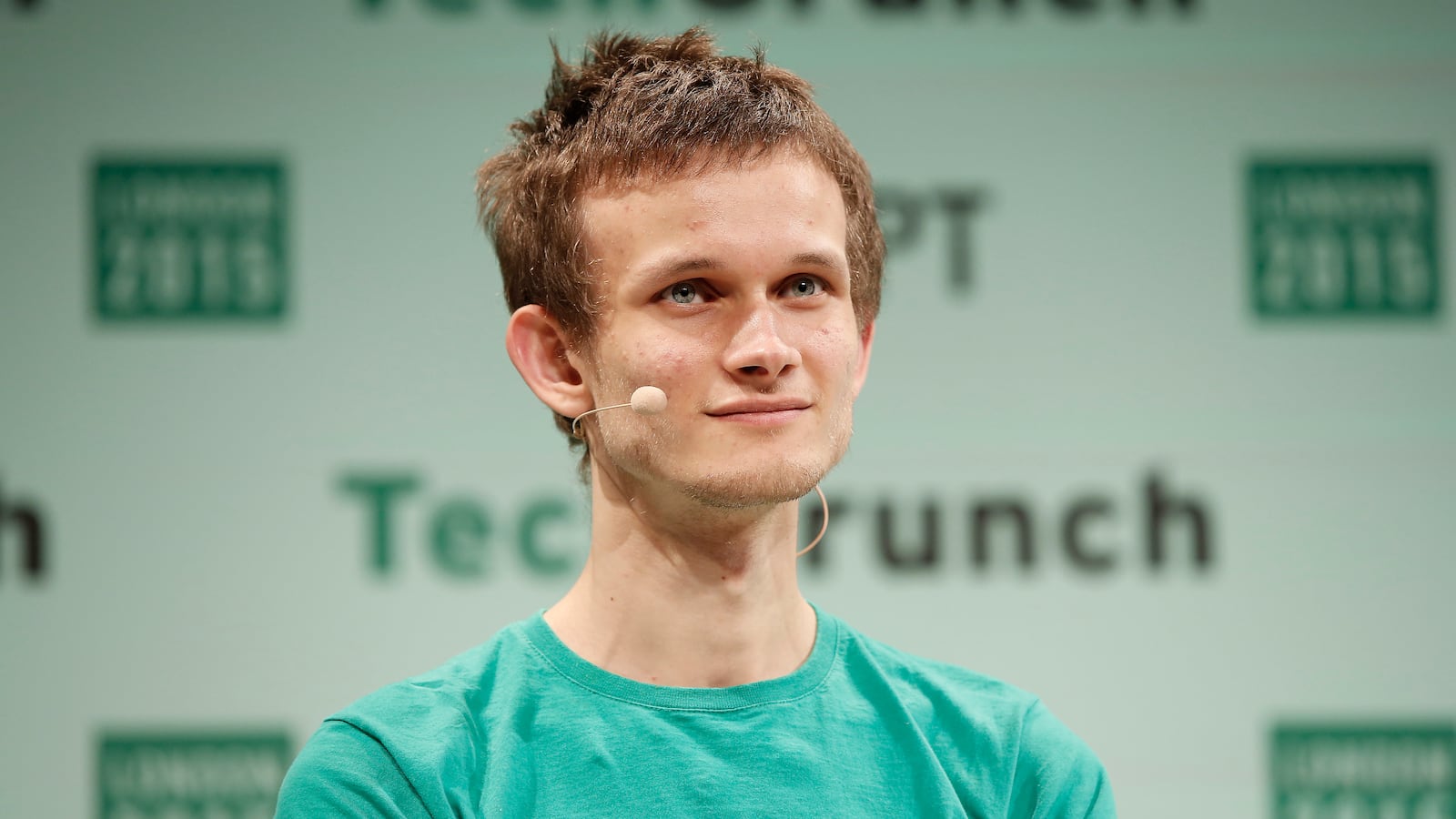Vitalik Buterin, the Russian-Canadian founder of Ethereum and vocal proponent of a wealth tax, became the world’s youngest billionaire this week, after a bull run pushed the cryptocurrency’s price up to nearly 350 percent its value at the beginning of the year.
The 27-year-old’s fortune is held in Ether, the Ethereum blockchain’s native token, rather than dollars or another currency. Buterin owns approximately 334,000 Ether, which were trading for just above $3,415 per coin on Wednesday afternoon. At that value, his wallet is worth about $1.14 billion.
The gangly, somewhat elfin founder is Russian by birth—born in a small, nearly 1,000-year-old city to the southeast of Moscow—but he grew up in Canada. His mother and father, a financial analyst and computer scientist respectively, migrated for better job opportunities, sending Buterin to private school where he became interested in their fields—programming, economics—and later, in Bitcoin.
In 2013, Buterin published a white paper for a project called Ethereum, a name he nicked from a Wikipedia page for science fiction elements. The paper proposed a decentralized platform that would repurpose the blockchain technology behind Bitcoin to incorporate “smart contracts”—pieces of code representing immutable agreements between a buyer and seller, which would self-execute without the need for a centralized authority. Theoretically, a user could then exchange not just tokens on the blockchain, but other assets, like homes, liens, or stocks.
After raising approximately $18 million in funding, Buterin and several developers launched the first version of the network in July of 2015. For its first year, the currency floundered somewhat: the price gradually rose until a major hack in 2016 disappeared some $50 million in Ether and crashed the token’s value. But the cryptocurrency boom of 2017 multiplied Ethereum’s price, shooting from $8 to a high of $840 over the year. The token has since grown in popularity. Its market cap approached $19 billion in April of 2020; as of Wednesday, it is nearly $395 billion. Here’s what to know about the man behind it:
He was a Thiel Fellow
Before publishing the Ethereum white paper, Buterin briefly enrolled at the University of Waterloo, where he studied with the well-known cryptographer Ian Goldberg, credited with designing a widely-used protocol for encrypted instant messages, and co-founded the crypto publication, Bitcoin Magazine. But in 2013, at the end of his spring semester, he won a “Thiel Fellowship” —a two-year program that awards $100,000 each year to two dozen college students, if they agree to drop out of college and start something of their own—in Buterin’s case, writing for the magazine and developing Ethereum.
Founded in 2010, the fellowship is the pet project of PayPal founder and Palantir executive Peter Thiel—the idiosyncratic billionaire whose other passions include extinguishing a media outlet through covertly funded lawsuits, bankrolling pseudo-blue collar author J.D. Vance’s burgeoning GOP political career, and psychedelic mushrooms.
He was the subject of a death hoax
In June of 2017, during the cryptoboom that made Ethereum the most prominent Bitcoin rival, rumors proliferated on social media that the founder had died. The myth, according to a report in Coindesk, first emerged on 4chan, where posts in the business forum alleged he had been killed in a car crash. There was no evidence of his death, but the tale gained traction online when it was picked up and tweeted by the website VioNews (the publication later deleted both story and tweet).
To prove that he was alive, Buterin tweeted out a picture of himself holding a handwritten note. He’d scrawled the number of the most recent Ethereum block on the chain, with what’s called the “hash”—a unique number allotted to every block as part of its encryption.
The move was a reference to a stunt WikiLeaks’ Julian Assange had pulled just months earlier in response to a death hoax of his own, using the most recent Bitcoin block hash. In both instances, the hashes would have been next to impossible to guess, illustrating that both Buterin and Assange were very much alive and online.
He met with Vladimir Putin
In June of 2017, around the same time that Buterin was rumored to be dead, he met with Russian President Vladimir Putin to discuss Russia’s burgeoning crypto space. At the time, cryptocurrencies still had limited official acceptance in the American or European finance worlds, but even less so in Russia.
That year, according to CNN, the Russian central bank issued warnings against the tokens. The anonymity of Bitcoin and related currencies, the bank suggested, could promote “illegal activities” like money laundering and funding terrorism. A bank official later mentioned possible restrictions on cryptocurrency vendors.
But on June 2, a release from the Kremlin announced that Putin had met with Buterin at the St. Petersburg International Economic Forum, following a meeting with foreign executives. According to the release, the Ethereum CEO developed “described the opportunities for using the technologies he developed in Russia.” In response, Putin reportedly “supported the idea of establishing ties with possible Russian partners.”
He once confronted a fake Satoshi Nakamoto
In 2018, Buterin attended Deconomy, a technology conference in Seoul which planned a large crypto-related event called “Bitcoin: Controversy Over Principle.” The event’s panelists included early Bitcoin proponent Roger Ver, CEO of Blockstream Samson Mow, and a controversial Australian businessman named Craig Wright.
Wright has become a notorious figure in the crypto world, due to a 2015 article in Wired that identified him as Satoshi Nakamoto, only to retract the claim days later. Wright, however, embraced the misidentification and began to claim he was Nakamoto––speaking at conferences, filing lawsuits against detractors, and filing copyrights for Bitcoin-related identities.
Buterin, who has been outwardly critical of Wright’s claims, undertook to live-tweet the conference event, posting a series of 62 tweets throughout the panel discussion—the majority of which took aim at Wright.
EMBED: Twitter
At the end of the event, Buterin aired his thoughts in person. During a Q&A with the panelists, he stood up to ask a question: “Given that [Craig Wright] made so many nonsequiturs and mistakes, why is this fraud allowed to speak at this conference?”
In a YouTube video from the event, the audience can be heard breaking out into loud applause. Wright didn’t answer.
He’s into life extension
On Twitter, Buterin’s pinned tweet lists seven “things [he’s] excited about. Number one is cryptography. Number two is “life extension.” The second item links to the Twitter account, which has since been suspended, named for the SENS Research Foundation–a California-based research facility dedicated to building the industry that “will cure the diseases of aging.” In addition to regenerative medicine research, the foundation hosts the Berlin conference series known as “Undoing Aging.”
In an interview with venture capitalist Morgan Beller, Buterin discussed his introduction to life extension, pointing to author Aubrey de Grey’s book, Ending Aging. “That was the book that kind of originally indoctrinated me into life extensionism,” he said, going on to describe some studies into longevity trials, including some on “parabiosis,” or the infusion of young blood into older people.
“This idea got reported on a few times because it just plays so perfectly into the kind of evil Silicon Valley-like vampire stereotypes,” Buterin said. “It was somewhat inconclusive, but of course, it really captured the imagination, just because of the bloody optics of the thing.”
Asked about the potential risks of longevity, Buterin said that other forms of human enhancement seemed more concerning. “Some people being much stronger and much smarter than others is definitely one risk,” he said. “And just being elitist, kind of making sure that these enhancements that we end up creating actually are available to everyone.”
An earlier version of this article stated that on Twitter, Buterin linked to a suspended account belonging to the SENS Research Foundation. The linked Twitter handle, while named for the Foundation, was not SENS' official account. Their account not been suspended.

